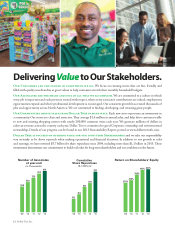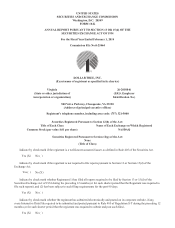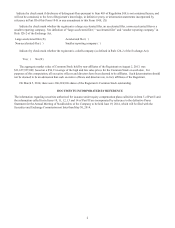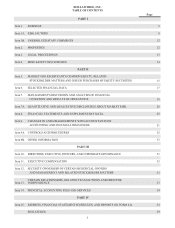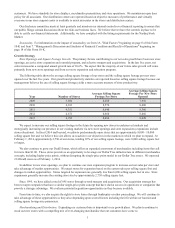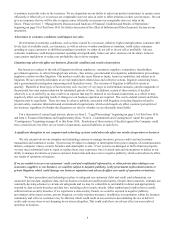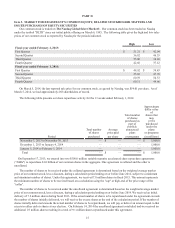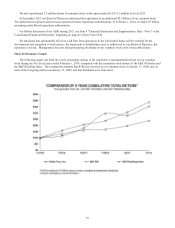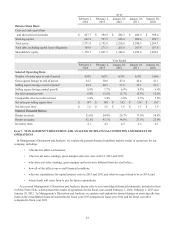Dollar Tree 2013 Annual Report Download - page 24
Download and view the complete annual report
Please find page 24 of the 2013 Dollar Tree annual report below. You can navigate through the pages in the report by either clicking on the pages listed below, or by using the keyword search tool below to find specific information within the annual report.8
appreciate. Consumable merchandise typically leads to more frequent return trips to our stores resulting in increased
sales. The presentation and display of merchandise in our stores are critical to communicating value to our customers and
creating a more exciting shopping experience. We believe our approach to visual merchandising results in higher sales volume
and an environment that encourages impulse purchases.
A strong and efficient distribution network is critical to our ability to grow and to maintain a low-cost operating structure.
In 2013, we completed construction on a new 1.0 million square foot distribution center in Windsor, Connecticut which began
shipping merchandise in June 2013 and expanded our Marietta, Oklahoma distribution center to 1.0 million square feet. In
addition, we leased an additional 0.4 million square feet at our San Bernardino, California distribution center in 2013. In 2011,
we expanded our Savannah, Georgia distribution center to 1.0 million square feet. We believe our distribution center network
is currently capable of supporting approximately $10.2 billion in annual sales in the United States. New distribution sites are
strategically located to reduce stem miles, maintain flexibility and improve efficiency in our store service areas. We also are a
party to an agreement which provides distribution services from two facilities in Canada.
Our stores receive approximately 90% of their inventory from our distribution centers via contract carriers. The remaining
store inventory, primarily perishable consumable items and other vendor-maintained display items, are delivered directly to our
stores from vendors. For more information on our distribution center network, see Item 2 “Properties” beginning on page 12 of
this Form 10-K.
Competition
The retail industry is highly competitive and we expect competition to increase in the future. We operate in the discount
retail merchandise business, which is currently and is expected to continue to be highly competitive with respect to price, store
location, merchandise quality, assortment and presentation, and customer service. Our competitors include single-price dollar
stores, multi-price dollar stores, mass merchandisers, discount retailers and variety retailers. In addition, several competitors
have locations with dollar price point merchandise in their stores, which increases competition. We believe we differentiate
ourselves from other retailers by providing high value, high quality, low cost merchandise in attractively designed stores that
are conveniently located. Our sales and profits could be reduced by increases in competition. There are no significant
economic barriers for others to enter our retail sector.
Trademarks
We are the owners of several federal service mark registrations including "Dollar Tree," the "Dollar Tree" logo, the Dollar
Tree logo with a “1”, and "One Price...One Dollar." In addition, we own a concurrent use registration for "Dollar Bill$" and the
related logo. We also acquired the rights to use trade names previously owned by Everything's A Dollar, a former competitor in
the $1.00 price point industry. Several trade names were included in the purchase, including the marks "Everything's $1.00 We
Mean Everything!," and "Everything's $1.00." With the acquisition of Deal$, we became the owners of the trademark
"Deal$”. With the acquisition of Dollar Giant, we became the owners of the trademark “Dollar Giant” and others in
Canada. We have federal trademark registrations for a variety of private labels that we use to market some of our product
lines. Our trademark registrations have various expiration dates; however, assuming that the trademark registrations are
properly renewed, they have a perpetual duration.
Employees
We employed approximately 17,600 full-time and 69,800 part-time associates on February 1, 2014. Part-time associates
work an average of less than 30 hours per week. The number of part-time associates fluctuates depending on seasonal
needs. We consider our relationship with our associates to be good, and we have not experienced significant interruptions of
operations due to labor disagreements.
Item 1A. RISK FACTORS
An investment in our common stock involves a high degree of risk. Any failure to meet market expectations, including our
comparable store sales growth rate, earnings and earnings per share or new store openings, could cause the market price of our
stock to decline. You should carefully consider the specific risk factors listed below together with all other information
included or incorporated in this report. Any of the following risks may materialize, and additional risks not known to us, or that
we now deem immaterial, may arise. In such event, our business, financial condition, results of operations or prospects could
be materially adversely affected.
Our profitability is vulnerable to cost increases.
Future increase in costs such as the cost of merchandise, wage and benefit costs, shipping rates, freight costs, fuel costs and
store occupancy costs may reduce our profitability. The minimum wage has increased or is scheduled to increase in multiple
states and local jurisdictions and there is a possibility that Congress will increase the federal minimum wage. We do not raise
the sales price of our merchandise to offset cost increases because we are committed to selling primarily at the $1.00 price point


